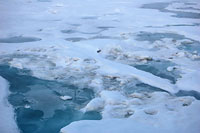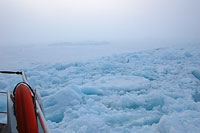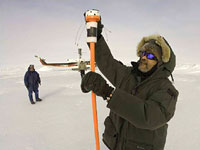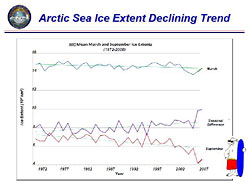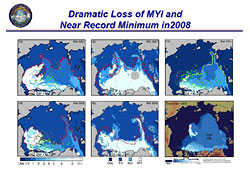

 | |||||||||||||||||
|
|
Journals 2009/2010Jonathan Pazol
August 30, 2009 Back and ram. Back and ram. Back and ram. Both the Healy and the Louis got stuck several times in the ice today, so they would back up and then ram ahead through the blockage. We were in mostly Multi Year ice (MYI), and the ridges were fairly large. Some of the ice was "dirty ice," which had chunks of dirt and some rock embedded in it. This is ice that had been pack ice (ice that is attached/covering land) and had broken off.
In addition, the ice chunks that we had moved through closed up on us pretty quickly. I never really understood how early Arctic and Antarctic explorers (Shackleton in the Antarctic) could become icebound and then have the ships crushed. But after the past few days, it is much more understandable. The force of the ice is incredible, even against ships this modern and powerful. And, from what people have said, the ice this year is not even that thick.
Many news reports and stories have been written about the loss of ice in the Arctic due to global climate change. On the Healy this year are 5 scientists who work either for the National Ice Center (NIC) or the Canadian Ice Center, and their jobs are to document ice coverage in the area. Pablo Clement-Colon, from Puerto Rico (even he doesn't quite know how to explain how he ended up studying ice), is a Chief Scientist from NIC, and he is here coordinating efforts to measure the extent of the total sea ice coverage and the amount of Multi Year ice.
From 1972 through 2008, the amount of sea ice in the Arctic, especially after the melt season ends in September, has decreased a great deal. 2007 was the record for the minimum amount of sea ice ever recorded - the amount was down almost 40% from the 1970s.
This decline is due to a variety of factors, including an increase in overall Arctic temperature (twice the amount of warming in the Arctic than the global average), changes in the atmosphere, which causes more ice to be swept out of the Arctic Ocean, increased sunlight absorption by open water than by ice (causes further warming), and warmer water flowing into the Arctic Ocean from the Atlantic and Pacific Oceans. While some of these are part of the natural cycles in the Arctic, it is clear that the past few years have resulted in a "perfect storm" of conditions, where more and more ice melted. Another effect of the greater loss of overall ice is the loss of the Multi Year ice. While the total ice coverage increased in 2008 from 2007, the "age" of the ice decreased. The picture below shows a comparison of several satellite composite images from March 2007 to March 2008. In the column on the right, the white areas represent ice that is 10+ years old. Notice how little there is left in the bottom right corner.
The loss of total ice cover and the decreasing age of the Multi Year ice clearly represent a change in the Arctic ecosystem. Various groups are exploring the commercial benefits of these changes, such as increased trans-polar shipping and mineral extraction; however, the non-commercial effects of less ice are potentially devastating. Whether the result of natural forces, anthropogenic (human) influence, or a combination of the two, sea ice loss will have a variety of negative ecological effects - marine mammal (seals, polar bears, and walruses) habitat loss, changes in water temperature and nutrient levels, and further climate change. There will also be human consequences for the people of the Arctic, as less sea ice will cause greater storms and more erosion, thus threatening coastal towns like Barrow. In addition, as animals change migration paths in response to ice patterns, native Inupiat cultural practices, such as subsistence hunting (hunting in order to feed families) will suffer. |
||||||||||||||||
